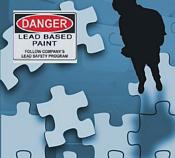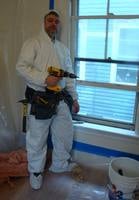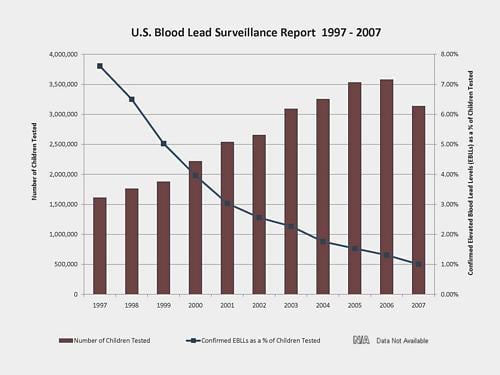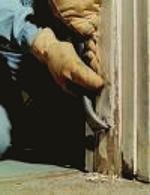Former Detroit Lead Inspector Sentenced for Fraud
 According to an article in the Detroit Free Press, Donald Patterson, a former lead inspector for the City of Detroit, was indicted last year on charges of soliciting bribes, wire fraud and making false statements about lead inspections. Among the allegations were that he allowed a 2-year-old child with high blood-lead levels to return to a home with lead-based paint hazards, falsely declaring it safe and making the child sicker.
According to an article in the Detroit Free Press, Donald Patterson, a former lead inspector for the City of Detroit, was indicted last year on charges of soliciting bribes, wire fraud and making false statements about lead inspections. Among the allegations were that he allowed a 2-year-old child with high blood-lead levels to return to a home with lead-based paint hazards, falsely declaring it safe and making the child sicker.
 The following is News Release from EPA, published on February 8, 2011. Though not specific to the RRP Rule, this action by both EPA and the FBI shows that willfull violators of lead related regulations are currently a major focus for EPA and they are serious about prosecuting violators.
The following is News Release from EPA, published on February 8, 2011. Though not specific to the RRP Rule, this action by both EPA and the FBI shows that willfull violators of lead related regulations are currently a major focus for EPA and they are serious about prosecuting violators.
EPA uses news releases and press releases like the one below to make the public aware of LBP related violations. The use and purposes of the releases as tools is clearly explained in footnote #10 included inside the Consolidated Enforcement Response and Penalty Policy for the RRP Rule:
"EPA may, at its discretion, issue a press release or advisory to notify the public of the filing of an enforcement action, settlement, or adjudication concerning a person’s violation of TSCA. A press release can be a useful tool to notify the public of Agency actions for TSCA noncompliance and specifically, to educate the public on the requirements of LBP Program. The issuance of a press release or advisory as well as the nature of their contents are within the sole discretion of the Agency and shall not be subject to negotiation with the violator."
News Release as Follows:
CONTACT:
Stacy Kika
kika.stacy@epa.gov
202-564-0906
202-564-4355
WASHINGTON — Former city of Detroit Health Department lead inspector Donald Patterson was sentenced today to three years and 10 months in prison and 24 months of supervised release on wire fraud charges stemming from an U.S. Environmental Protection Agency (EPA) investigation. In July 2010, Patterson pleaded guilty and admitted he accepted cash to provide a clean bill of health to homes in which he had either done no inspection or provided fraudulent lead removal training. Lead is a serious public health issue causing a range of health effects from behavioral problems and learning disabilities, to seizures and death. Children six years old and under are most at risk.
“The actions of this public official put the health and lives of children at risk,” said Cynthia Giles, assistant administrator for EPA’s Office of Enforcement and Compliance Assurance. “In this case, the local government inspector failed to do his job by submitting false reports for personal gain. Today’s sentencing shows that those who knowingly put the public at risk, particularly our most vulnerable citizens, our children, will be prosecuted to the fullest extent of the law.”
Patterson, 50, was employed by the city of Detroit as a lead paint inspector. His job was to ensure that all paint-based lead hazards were safely removed from the homes he inspected. Instead, Patterson used his position to obtain cash from the owners or renters of these homes in exchange for falsely certifying that the homes were free of lead or for providing fraudulent lead removal training. Patterson admitted that between October 2008 and August 2009 he had accepted cash totaling $1,350 in connection with fraudulent abatement of lead hazards to which children were being exposed at four separate properties.
The Patterson case was investigated by EPA and the FBI, with assistance from the city of Detroit and the state of Michigan.
Michigan residents who have concerns about possible lead hazards in their homes should call the Michigan Department of Community Health Hotline at 800-648-6942.

 Looking for accurate information about the EPA RRP rule?
Looking for accurate information about the EPA RRP rule?  One Person’s Opinion: This is a guest blog submitted by Paul Lesieur to express his opinion. Paul is a Yankee trained craftsman and the founder of
One Person’s Opinion: This is a guest blog submitted by Paul Lesieur to express his opinion. Paul is a Yankee trained craftsman and the founder of 

 Property owners who renovate, repair, or prepare surfaces for painting in pre-1978 rental housing or space rented by child-care facilities must, before beginning work, provide tenants with a copy of EPA's lead hazard information pamphlet
Property owners who renovate, repair, or prepare surfaces for painting in pre-1978 rental housing or space rented by child-care facilities must, before beginning work, provide tenants with a copy of EPA's lead hazard information pamphlet  Beginning April 22, 2010, property owners who perform these projects in pre-1978 rental housing or space rented by child-care facilities
Beginning April 22, 2010, property owners who perform these projects in pre-1978 rental housing or space rented by child-care facilities  While deleading activities conducted in residences and child-occupied facilities often involve work methods similar to those typically used in renovation, repair or painting (RRP) activities, such as replacing windows, painting and installing vinyl siding, the two types of activities are distinct from each other in terms of purpose and effect.
While deleading activities conducted in residences and child-occupied facilities often involve work methods similar to those typically used in renovation, repair or painting (RRP) activities, such as replacing windows, painting and installing vinyl siding, the two types of activities are distinct from each other in terms of purpose and effect. Once you have made the initial determination regarding whether your project is a renovation project or a deleading project, the next question is how to choose a contractor who is licensed and qualified to perform the work. Click on the following link to view a helpful guide on choosing a deleading contractor, “
Once you have made the initial determination regarding whether your project is a renovation project or a deleading project, the next question is how to choose a contractor who is licensed and qualified to perform the work. Click on the following link to view a helpful guide on choosing a deleading contractor, “

 In a document dated December 1998 EPA received a
In a document dated December 1998 EPA received a  A
A  Perhaps industry trade associations can take advantage of this executive order to get EPA to rethink the current RRP rule. To protect the interests of renovators, at a minimum, the RRP Rule or any proposed amendments should reflect real scientific facts about EBLL’s caused by RRP activities and address the economic challenges currently being experienced by compliant businesses that have been complaining about illegal and unfair completion due to the lack of enforcement of the RRP Rule by EPA.
Perhaps industry trade associations can take advantage of this executive order to get EPA to rethink the current RRP rule. To protect the interests of renovators, at a minimum, the RRP Rule or any proposed amendments should reflect real scientific facts about EBLL’s caused by RRP activities and address the economic challenges currently being experienced by compliant businesses that have been complaining about illegal and unfair completion due to the lack of enforcement of the RRP Rule by EPA.  Although their primary purpose is to represent and protect their members, the efforts of these trade associations also benefit remodelers and therefore should be recognized. I thought this would be a good opportunity to recognize some of these associations. The list below is by no means complete as I am sure there are many other associations contributing as well. If I have missed any that you know of please name them by posting a comment below. I will add them to the list in the body of this article as I am made aware of them.
Although their primary purpose is to represent and protect their members, the efforts of these trade associations also benefit remodelers and therefore should be recognized. I thought this would be a good opportunity to recognize some of these associations. The list below is by no means complete as I am sure there are many other associations contributing as well. If I have missed any that you know of please name them by posting a comment below. I will add them to the list in the body of this article as I am made aware of them. Note: The following information was
Note: The following information was  Contractors that remodel or demolition homes, schools, or facilities where children regularly visit, constructed in and before1978, are required to obtain from the CCB, a certified Lead-Based Paint Renovation (LBPR) Contractors license. To qualify, an owner or employee must complete the RRP training from an approved provider and complete a CCB LBPR application. The license is $50 a year and can be renewed annually.
Contractors that remodel or demolition homes, schools, or facilities where children regularly visit, constructed in and before1978, are required to obtain from the CCB, a certified Lead-Based Paint Renovation (LBPR) Contractors license. To qualify, an owner or employee must complete the RRP training from an approved provider and complete a CCB LBPR application. The license is $50 a year and can be renewed annually. Two recent efforts by trade associations recently came across my attention. One was by the National Association of the Remodeling Industry (NARI). In a
Two recent efforts by trade associations recently came across my attention. One was by the National Association of the Remodeling Industry (NARI). In a  I suggest that the two letters contain some very good points and are well written. Renovators with similar concerns could, using the content of these two letters as a reference, write to their own local politicians and or to EPA to express their concerns and demand that EPA recognize the challenges small businesses are having as a result of the rule as well as EPA’s lack of adequate administration and enforcement of the rule.
I suggest that the two letters contain some very good points and are well written. Renovators with similar concerns could, using the content of these two letters as a reference, write to their own local politicians and or to EPA to express their concerns and demand that EPA recognize the challenges small businesses are having as a result of the rule as well as EPA’s lack of adequate administration and enforcement of the rule.
 “Number of events and individuals affected: In the first year that all of the rule requirements will be in effect, there will be an estimated 8.4 million renovation, repair, and painting events where lead-safe work practices will be used due to the rule. As a result, there will be approximately 1.4 million children under the age of 6 who will be affected by having their exposure to lead dust minimized due to the rule. There will also be about 5.4 million adults who will be affected. After improved test kits for determining whether a painted surface contains lead-based paint become available (which is assumed in the analysis to occur by the second year of the rule), the number of renovation, repair, and painting events using lead-safe work practices is expected to drop to 4.4 million events per year. No change in the number of exposures avoided due to the rule is expected because the improved test kit will more accurately identify paint without lead, thus reducing the number of events unnecessarily using the required work practices.”
“Number of events and individuals affected: In the first year that all of the rule requirements will be in effect, there will be an estimated 8.4 million renovation, repair, and painting events where lead-safe work practices will be used due to the rule. As a result, there will be approximately 1.4 million children under the age of 6 who will be affected by having their exposure to lead dust minimized due to the rule. There will also be about 5.4 million adults who will be affected. After improved test kits for determining whether a painted surface contains lead-based paint become available (which is assumed in the analysis to occur by the second year of the rule), the number of renovation, repair, and painting events using lead-safe work practices is expected to drop to 4.4 million events per year. No change in the number of exposures avoided due to the rule is expected because the improved test kit will more accurately identify paint without lead, thus reducing the number of events unnecessarily using the required work practices.”


